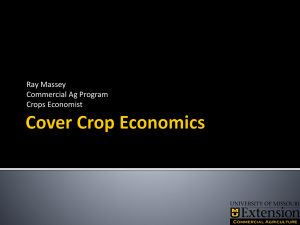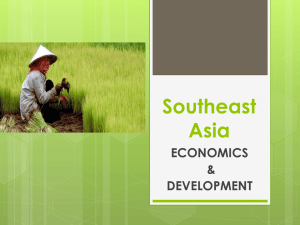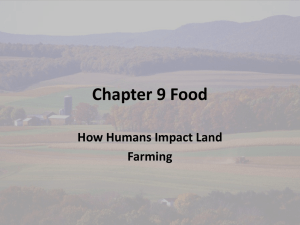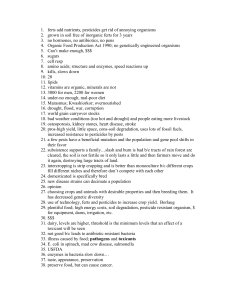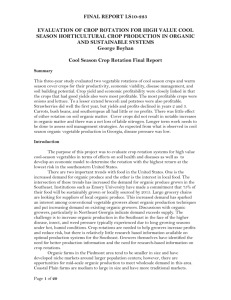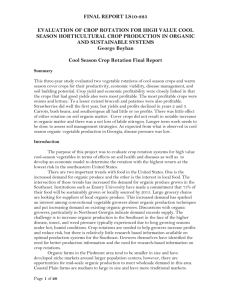Barrie Paige Barrie Sonja Andrus English 1001 23 January 2013
advertisement
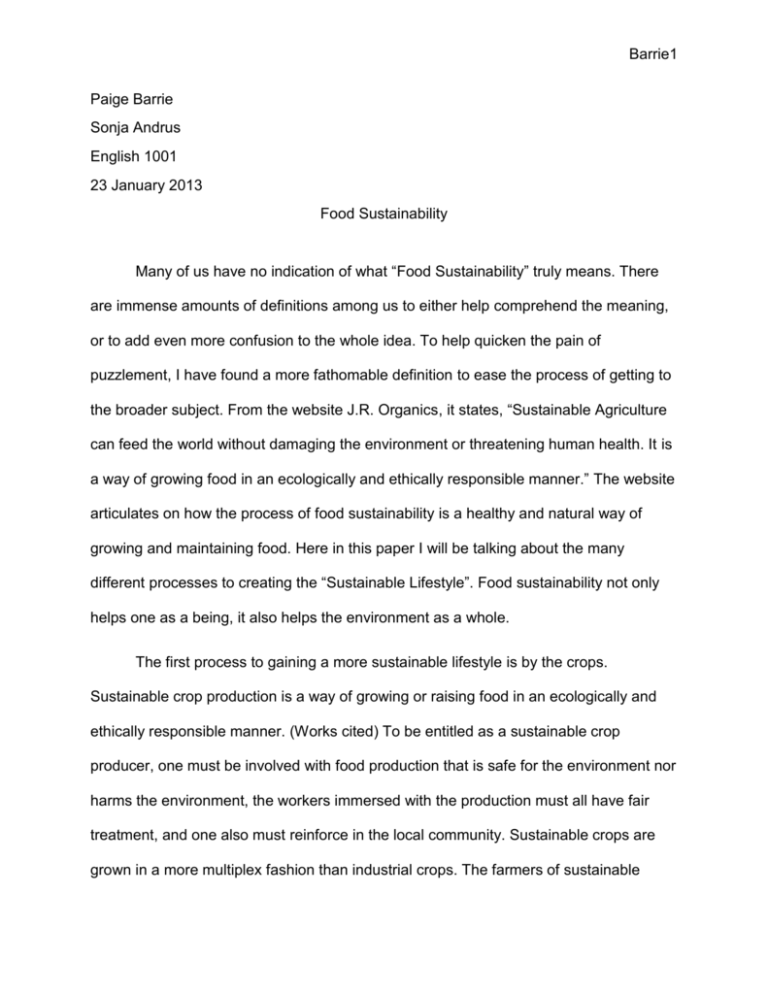
Barrie1 Paige Barrie Sonja Andrus English 1001 23 January 2013 Food Sustainability Many of us have no indication of what “Food Sustainability” truly means. There are immense amounts of definitions among us to either help comprehend the meaning, or to add even more confusion to the whole idea. To help quicken the pain of puzzlement, I have found a more fathomable definition to ease the process of getting to the broader subject. From the website J.R. Organics, it states, “Sustainable Agriculture can feed the world without damaging the environment or threatening human health. It is a way of growing food in an ecologically and ethically responsible manner.” The website articulates on how the process of food sustainability is a healthy and natural way of growing and maintaining food. Here in this paper I will be talking about the many different processes to creating the “Sustainable Lifestyle”. Food sustainability not only helps one as a being, it also helps the environment as a whole. The first process to gaining a more sustainable lifestyle is by the crops. Sustainable crop production is a way of growing or raising food in an ecologically and ethically responsible manner. (Works cited) To be entitled as a sustainable crop producer, one must be involved with food production that is safe for the environment nor harms the environment, the workers immersed with the production must all have fair treatment, and one also must reinforce in the local community. Sustainable crops are grown in a more multiplex fashion than industrial crops. The farmers of sustainable Barrie2 crops are more focused on keeping the produce environmentally friendly and sustainable over a period of time. There are many different methods used in a sustainable crop production like; Multicropping, minimal to no pesticide use, soil health, and seeds and plant varieties. Multicropping can be described as planting number of different natures of crops all on one format of land. With Multicropping a farmer can use methods like, Crop rotation and Intercropping. Crop rotation is the practice of changing the crop that is planted on the land from season to season to different crops. Intercropping can be interpreted as planting two or more crops that differ in characteristics in close proximity to reduce weeds, which includes companion planting and the use of cover crops. Intercropping can also have the benefits of providing shade for one another, getting rid of insects or pests, or other benefits for the plants well-being. There are many different advantages of the Multicropping method for the sustainable crop production. For example one of the advantages would be increased biodiversity, which by having a number of different natures of plants can add nitrogen fixation for the soil, repel pests, and provide shade. Which is good for the environment because all plants will be protected by using natural resources and not having to use harmful pesticides. Another method used in the crop production for sustainable food would be the minimal to no use of pesticides. Pesticides are used to kill off weeds, insects, or bacteria that may affect the plants being. They also can be very dangerous to humans, like the farmers who have to put the pesticides on the plants, and can also be very dangerous to the environment by causing water pollution and soil contamination. Pesticides have been perceived to cause certain types of cancers, and cause Barrie3 neurological problems to a human’s heath. By doing crop production it reduces many numbers of the uses of pesticides, and even some farmers don’t even use pesticides at all. By having minimal to no usage of the pesticides on the crops, it leads to a number of healthy benefits to the people and to the economy. Soil health of the crops is another main aspect of the production of sustainable food. It is to be said that in result of focusing on the soil health, the crops are to be higher in vital macro- and micronutrients. There are quite a number of different growing practices when focusing on the soils health. There is the use of organic fertilizer, that when used the uptake of nutrients are increased by plants and also improving the nutrient value of the plants themselves. Inorganic fertilizers can cause the soils health to impair overtime, which will lead to more use of the fertilizer eventually causing more and more money to be spent on the fertilizer and killing the soil. Another practice with focusing on the soils health would be crop rotation, intercropping, and mulching. By doing this it helps replenish the soil. Intercropping and crop rotation can increase the soils health by adding plants that fix nitrogen. Crop rotation will increase yields to the plants, and also lets the plants replenish all of their micronutrients, microbes, and other important mechanisms. Last, Mulching will retain critical soil moisture and can reduce soil erosion. By Focusing on the soil's health it will also help with the environment by reducing the use of heavy machinery. Farmers over time will use an enormous amount of gas to fill up their machine's gas tanks just so they take care of their crops, which then outcomes to polluting the air. Lastly, Seed and plant variety selection is a vital component to sustainable crop production. Industrial crop productions tend to lean more towards fast growth of the Barrie4 plants, ease of mechanical harvest, and plant varieties when selecting their seeds. Rather than flavor and nutritional content like sustainable crop productions do. Industrial crop productions like to take easy routes when it comes to harvesting their plants and the labor it comes with. Which has resulted to the loss of biodiversity and a major decline in nutrients. Last sustainable crop productions reject the usage of genetically engineered crops due to their potent environmental impacts, and the uncertainty of their healthfulness. After constructing a stable sustainable crop production, initiating a sustainable livestock is the next action. A sustainable livestock can be portrayed as to be where the animals are granted to roam freely and eat nourishing and digestible plants on large natural environments. Not only is having a sustainable lifestyle for the animals a dramatic upgrade, it also improves the taste and nutrients in the meat, eggs, and dairy.

